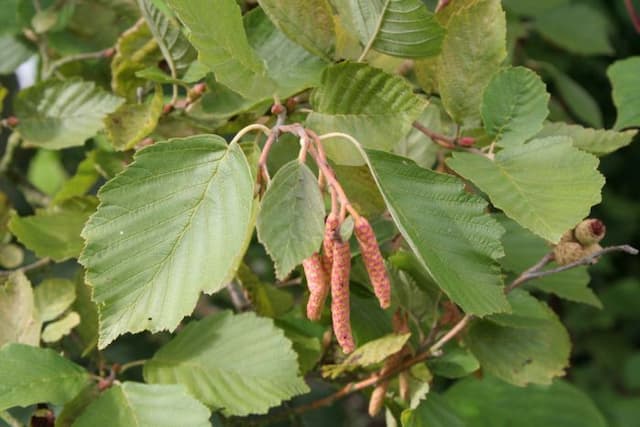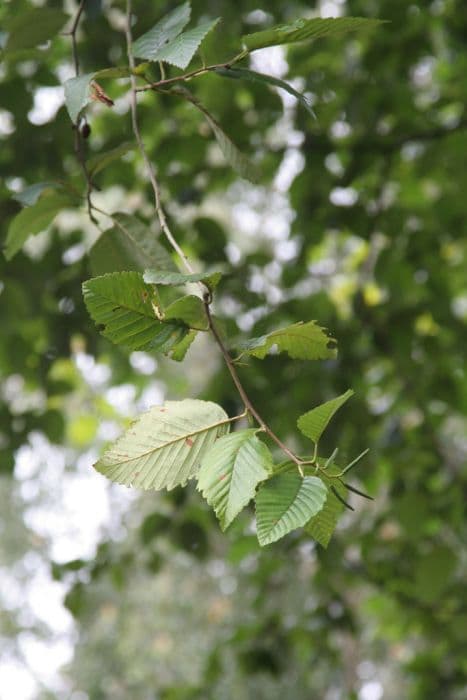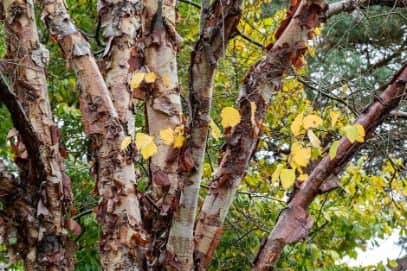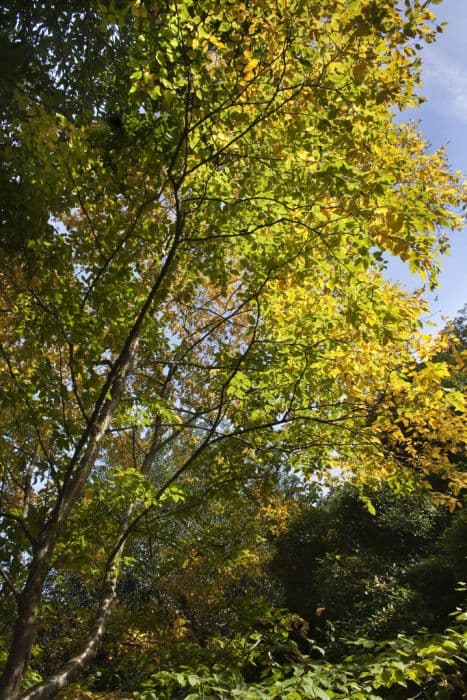Korean hornbeam Carpinus turczaninowii
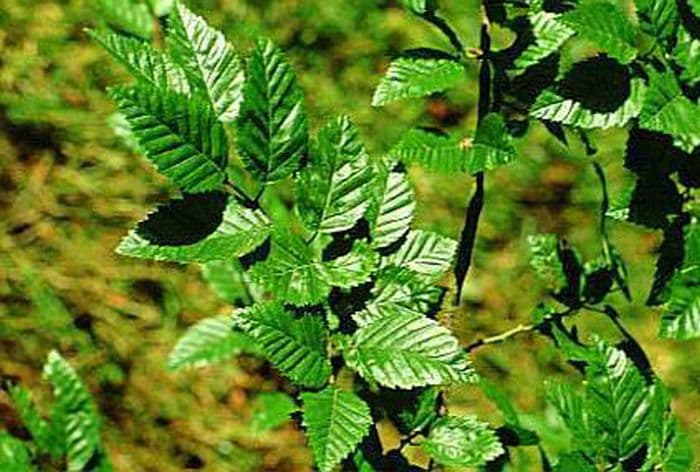
ABOUT
The plant known as Hornbeam boasts a striking appearance with foliage that changes with the seasons. During spring, its leaves emerge with a fresh green hue, which gradually transitions into a darker green as the plant matures into summer. Come autumn, the leaves take on a colorful display of yellows and golds before they eventually fall off. The leaves exhibit a toothed edge, giving them a serrated look, and they are arranged neatly on the branches, providing a dense, lush canopy. The bark of the Hornbeam is smooth and has a grayish tone which can sometimes appear slightly silver, adding to its visual appeal throughout the year. Its branches spread elegantly and are arranged in a way that gives the plant a well-structured, ornamental look. Flowering occurs in the form of catkins, which are inconspicuous clusters that dangle from the branches. These catkins are usually a greenish-yellow color, blending harmoniously with the foliage. The fruits produced are small and inconspicuous as well, nestled inside bracts that can be leaf-like in appearance. Overall, the Hornbeam has a well-rounded, graceful form that can add a touch of sophistication to any landscape in which it is planted, with a seasonal rhythm that keeps it interesting throughout the year.
About this plant
 Names
NamesFamily
Betulaceae
Synonyms
Korean Hornbeam, Turczaninow's Hornbeam
Common names
Carpinus laxiflora, Carpinus pubescens.
 Toxicity
ToxicityTo humans
The Carpinus turczaninowii, commonly referred to as Korean hornbeam, is not widely recognized as a toxic plant to humans. There is very little information available about the toxicity of this plant. Ingesting any part of the plant is not typically associated with poisoning or adverse health effects in humans. However, it is always prudent to exercise caution and avoid consuming parts of ornamental plants as their chemical properties can vary and ingestion is generally not recommended unless specifically stated as safe.
To pets
The Korean hornbeam (Carpinus turczaninowii) is not commonly known to be toxic to pets. There is limited information on its toxicity and it does not appear on common lists of plants that are poisonous to domestic animals such as dogs and cats. In the absence of specific toxicity data, it is wise to prevent pets from ingesting plants not known to be safe, as they might cause gastrointestinal upset or other health issues simply due to their being non-food items. If you suspect your pet has consumed any part of the Korean hornbeam and is showing signs of illness, contact a veterinarian.
 Characteristics
CharacteristicsLife cycle
Perennials
Foliage type
Deciduous
Color of leaves
Green
Height
20 feet (6 meters)
Spread
15 feet (4.5 meters)
Plant type
Tree
Hardiness zones
5
Native area
Korea
Benefits
 General Benefits
General Benefits- Aesthetic Value: Hornbeam Maple adds ornamental appeal to landscapes with its attractive foliage and form.
- Shade Provider: Offers shade in gardens and parks, which can help to cool surrounding areas.
- Habitat for Wildlife: Provides food and shelter for various species of birds and insects.
- Erosion Control: The root system can help stabilize soil and prevent erosion.
- Carbon Sequestration: Contributes to carbon storage, helping to mitigate the effects of climate change.
- Windbreak: Can be used in a row to create a windbreak, reducing the impact of high winds on soil and plants.
 Medical Properties
Medical PropertiesThis plant is not used for medical purposes.
 Air-purifying Qualities
Air-purifying QualitiesThis plant is not specifically known for air purifying qualities.
 Other Uses
Other Uses- Carpinus turczaninowii, commonly known as the Korean hornbeam, can be used to create bonsai due to its small leaves and attractive, gnarled bark which gives it an aged appearance even when young.
- Its durable wood is suitable for crafting tool handles, as it provides a sturdy grip and can withstand repeated use and wear.
- The Korean hornbeam's wood is also valued for use in woodturning, providing a medium for artisans to create decorative and functional wooden objects.
- This plant's dense canopy can be utilized in landscaping to create privacy screens or hedges in gardens and parks.
- The Korean hornbeam's symmetrical shape and attractive foliage make it an excellent choice for formal garden design or as a feature tree in urban settings.
- Its branches and twigs may be harvested and used in floral arrangements, providing a strong and long-lasting structural element.
- The wood of Carpinus turczaninowii burns slowly and hot, making it suitable for use as firewood in areas where it is abundant.
- The tree can be planted along riverbanks or on slopes for soil erosion control, thanks to its extensive root system that holds the soil firmly.
- As it provides dense shade, the Korean hornbeam can be strategically planted to reduce cooling costs by shading buildings during hot months.
- The seeds of the hornbeam can be collected and used as a food source for wildlife, supporting local ecosystems and attracting birds to the area.
Interesting Facts
 Feng Shui
Feng ShuiThe Hornbeam is not used in Feng Shui practice.
 Zodiac Sign Compitability
Zodiac Sign CompitabilityThe Hornbeam is not used in astrology practice.
 Plant Symbolism
Plant Symbolism- Resilience: Carpinus turczaninowii, known as Korean Hornbeam, is a hardy plant which can symbolize the ability to withstand adverse conditions and bounce back from difficulties.
- Strength: The wood of the Korean Hornbeam is dense and strong, making it a symbol of inner strength and fortitude.
- Flexibility: Despite its strength, the wood is also quite flexible, representing adaptability and the ability to bend without breaking.
- Longevity: The Korean Hornbeam can live for many years, symbolizing long life and endurance.
- Peace: Its smooth gray bark and pleasing shape give a sense of calm and tranquility, making it a symbol of peace and serenity.
 Water
WaterThe Korean hornbeam should be watered deeply, ensuring that water reaches the root zone. During the growing season in spring and summer, watering should typically occur once every week, with about 1-2 gallons per plant, depending on the weather and soil moisture levels. In hot, dry conditions, you might need to water twice a week. Reduce watering frequency in fall before leaf drop and through winter to every two to three weeks, adjusting for precipitation and temperature. It's important to avoid waterlogging, so ensure the soil is well-draining.
 Light
LightKorean hornbeam thrives best in full sun to partial shade conditions. It is adaptable, though, and can tolerate a range of light scenarios. The best spot for the plant is in an area where it can receive at least four to six hours of direct sunlight each day, with some dappled shade during the hottest part of the afternoon.
 Temperature
TemperatureThe Korean hornbeam prefers temperate climates and can withstand temperatures ranging from about -20°F to 90°F. However, its ideal growing conditions are between 50°F and 70°F. Ensure that the plant is protected from extreme cold by offering insulation or windbreaks if temperatures dip below the minimum threshold.
 Pruning
PruningPrune the Korean hornbeam to maintain its shape and remove any dead or damaged branches. The best time for general pruning is in late winter or early spring before new growth starts. It may also be pruned in summer to remove undesirable or wayward branches. Prune sparingly and only as needed, as the Korean hornbeam naturally develops a well-structured form.
 Cleaning
CleaningAs needed
 Soil
SoilKorean hornbeam thrives in well-draining soil with pH ranging 5.5 to 7.5. A mix of loam, peat, and sharp sand is ideal for good root health and drainage. Regular amendments with organic matter will enhance soil fertility and structure.
 Repotting
RepottingKorean hornbeam should be repotted every 2 to 3 years during its period of active growth. Young trees can be repotted more frequently, while older specimens may require less frequent repotting.
 Humidity & Misting
Humidity & MistingKorean hornbeam prefers moderate to high humidity levels. Maintaining a humidity level of around 60-80% is beneficial for the plant's vitality, particularly during the active growing season.
 Suitable locations
Suitable locationsIndoor
Provide bright, indirect light and maintain humidity.
Outdoor
Plant in partial shade and shelter from strong winds.
Hardiness zone
4-8 USDA
 Life cycle
Life cycleCarpinus turczaninowii, commonly known as the Korean hornbeam, begins its life cycle as a seed which germinates in moist soil conditions, often in the spring after a period of cold stratification. The seedling emerges, developing a taproot and begins photosynthesis as it grows its first leaves. As the seedling matures into a sapling, it undergoes significant growth, establishing a woody stem and branching structure, typical of deciduous trees. Over several years, the sapling matures into an adult tree, capable of producing flowers; the flowers are monoecious, with both male catkins and small female inflorescences present on the same tree. After pollination, typically by wind, the female flowers develop into small, nut-like fruits, which are encased in leafy, winged bracts aiding in dispersal by wind. The mature Korean hornbeam reaches its reproductive age and can live for many years, completing its life cycle when it dies, decomposes, and provides nutrients back to the soil.
 Propogation
PropogationPropogation time
Spring to Summer
Propogation: Carpinus turczaninowii, commonly known as the Korean hornbeam, is best propagated by seed. The optimal time for sowing seeds is in the fall, directly after collection, as they exhibit dormancy and require a cold period to germinate. To propagate Korean hornbeam by seed, collect the seeds when they are ripe typically in late summer or early fall. Sow them immediately in a prepared seedbed or stratify them artificially by mixing the seeds with moist sand and placing them in a refrigerator at about 34 to 41 degrees Fahrenheit (1-5 degrees Celsius) for approximately 90-120 days. After cold stratification, seeds can be sown in containers or directly in the field in spring. Seedlings usually require a few years of growth before they are large enough to be transplanted to their final location.
